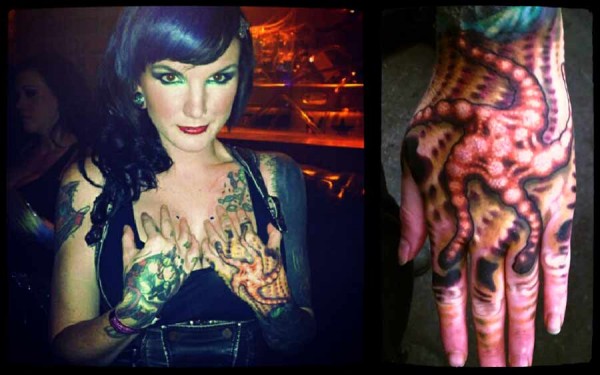I was looking at a picture that Steve Haworth just posted of his new biohazard symbol implant, and noticing all the people excited about it and saying they’d love to have one — which is great, and I should mention that if you’re in Europe, Steve is going to be working at the BMX conference in October (contact him at [email protected] to make an appointment) — and something struck me. You may have already noticed this yourself, but a very significant percentage of the implant market — easily upwards of two thirds; probably more — is what amounts to “flash”. Even though you’d think that implants would appeal to the most individualistic among us, the majority of implants are selected from a very small handful of designs. Someone gets a skull implant. Then so does someone else. And they’re not just similar — they are exactly the same. There is a very small palette of implants being done — a selection of beads and domes, some ribs, some body jewelry mimics, and a small assortment of symbols.
This is because making new implant designs is difficult and often expensive — especially if you’re not cutting corners and potentially creating contaminated implants with substandard materials or made in a less-than-clean environment. Creating a proper cast implant is a multi-step process that requires expertise, equipment, a laboratory-clean facility, and money — generally far more than a single client is capable of investing, which is why artists like Steve Haworth, who to the best of my knowledge are “doing things right” and not cutting corners, are forced to sell many copies of the same implant to make the product possible. The alternative is hand-carving blocks of silicone to shape, which is surprisingly difficult because of the nature of the material, and when not done perfectly comes with less pros and more cons. Another possibility — often seen on forehead projects — is combining multiple smaller implants into a complex arrangement. This can work nicely on a forehead, but implants are prone to shifting in many locations so this is not always an option, and in any case comes with significant design limitations.
In the tattoo world, there came a point, probably in the mid-1990s, when there evolved a broad general awareness that getting flash tattoos ran contrary to the spirit of rebellion and individual expression that drew people to tattoos in the first place. It wasn’t enough any more just to have “a cool tattoo” — people wanted “their own cool tattoo”. Even in body piercing we’ve seen an exponential increase in jewelry selection in the last decade. I wonder if we will see a paradigm shift in implants where people stop thinking it’s enough to a cool implant. Where people start insisting that their implant is their own — and like with copied tattoos, people start getting upset when they see someone else wearing the exact same implant? Of course the problem is that unlike tattooing where the basic “materials cost” of a custom tattoo is identical to piece of oft-repeated flash, with implants, ensuring uniqueness radically increases the unit cost.
Is it worth having limited design selection and the knowledge that many others wear the same implant as you do if it will get you an implant you’re willing to accept for $500 rather than the implant of your dreams for $5,000? Today it seems to be. But tomorrow? Time will tell whether opinions will change, or whether it is a matter of new materials and new manufacturing methods having to bring the prices down to what the market can support first. But given what people are willing to invest in their tattoos, I suspect it’s more a matter of people even knowing they have a choice that’s keeping this from happening.





















